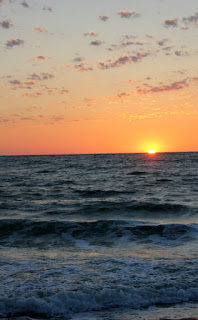 |
| Anhinga in Shark Valley |
Without being able to put into words why—other than “I want
to see this before it’s gone”—I’ve wanted to visit the Florida Everglades for
years. I’m ashamed to admit that before I went I knew virtually nothing about
it. I imagined a kind of giant swamp, filled with mosquitoes, alligators and
pythons. Happily, what I found instead was a place with its own quiet beauty—a beauty that is more than skin deep. What I was most struck by was the
intricate, often invisible, interconnection of life in the Everglades: plants,
birds, animals, insects—and ultimately humans—so dependent on each other. And
because it’s so interconnected, it’s also exceptionally sensitive and fragile. Threats to the health and survival of the Everglades include
runoff of fertilizers as well as other types of pollution from encroaching
urban areas, and the invasion of exotic/non-native plants and animals.
 |
| Just one of the many gators we saw |
A little history: The Everglades once covered nearly three
million acres, stretching from just below Orlando, through Lake Okeechobee, all
the way to the very tip of the peninsula, as well as east and west towards both
coasts. However, it was not always valued, or even understood. In
the early 1900s, even conservationists felt that the dredging of the Everglades
was the “smart, progressive thing to do.” The wetlands and marshes were seen as
worthless, and many areas were dredged, drained, and diked to make way for
agriculture and development. (One governor, Napoleon Bonaparte Broward, was
elected after running on a platform that included promising to drain the
Everglades.)
 |
| Baby gators--surprisingly cute! |
The Everglades became a national park in December of
1947. According the National Park Service website, “For the first time in
American history, a large tract of wilderness was permanently protected not for
its scenic value, but for the benefit of the unique diversity of life it
sustained. The mosaic of habitats found within the Greater Everglades Ecosystem
supports an assemblage of plant and animal species not found elsewhere on the
planet.” The park is approximately 1.5 million acres, but the Greater
Everglades Ecosystem is much larger than the national park itself.
 |
| A view from the 65-foot Shark Valley observation tower |
Kerri and I took parts of two days to explore, and could
easily have spent much more time there. The park is huge, and there are many
ways to see it: scenic drives, hiking, biking, canoeing, boat tours, and
naturalist-led guided tram tours. I highly recommend the tram tour at the Shark
Valley Visitor’s Center. I took most of the photos in this post while on this
tour. You can bike or hike the 15-mile loop the tram takes if you prefer, but I
learned a lot from the guide. (We also took an airboat tour, but it wasn’t
nearly as informative as the tram tour.) Some things I learned:
Seven million people (one out of every three Floridians)
rely on the Everglades for water.
The Everglades is not a swamp, but a very slow-moving river.
It flows at the speed of about 100 feet per day (contrast that with the
Mississippi, which at its headwaters, flows at an average speed of 1.2 miles
per hour). Talk about meandering.
 |
| View from the airboat |
 |
| Alligator approaching the airboat |
The Everglades is a UNESCO World Heritage Site and an
International Biosphere Reserve.
 |
| Buttonbush |
 |
| Purple gallinule |
Everglades National Park is the largest mangrove ecosystem
in the western hemisphere, the largest designated wilderness in the southeast,
and the most significant breeding ground for tropical wading birds in North
America.
 |
| Cormorant on the Anhinga Trail |
It’s the only place in the world where the American
Alligator and American Crocodile coexist.
 |
| Kerri at Eco Pond--the only place we battled mosquitoes |
We agreed that the more we learn about natural places like
the Everglades, the more questions we have, and the more we want to learn. For
me, that’s one of the happiest, most important benefits of travel: discovery
and the urge to know more.
 |
| A new friend--photo courtesy Kerri Dowd |
Thank you for reading
installment two of Kerri and Kathy’s road trip. I hope you’ll return next week for
our further adventures—we’re bound for the Florida Keys!
For more information on the Everglades:
The Everglades: River of Grass, Marjory Stoneman Douglas
The Swamp: The Everglades, Florida, and thePolitics of Paradise, Michael Grunwald












.jpg)


